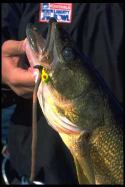Locals simply call Bohn the “Snag Master”
By Ted Takasaki and Scott Richardson
Call him “Snag Master.”
 Not only did legendary Wisconsin fishing guide Greg Bohn design the snag-free new Timb’r Rock Jig, he designed the NO-SNAGG Hook, which sports the same 7-strand wire hook guard. The hook marketed by Lindy Little Joe becomes a potent weapon when combined with the NO-Snagg Sinker, designed by Fishing Hall of Fame member Ron Linder.
Not only did legendary Wisconsin fishing guide Greg Bohn design the snag-free new Timb’r Rock Jig, he designed the NO-SNAGG Hook, which sports the same 7-strand wire hook guard. The hook marketed by Lindy Little Joe becomes a potent weapon when combined with the NO-Snagg Sinker, designed by Fishing Hall of Fame member Ron Linder.
The NO-SNAGG revolution began when a futuristic-looking snagless sinker hit the market in the Spring of 1999 to boldly go where no sinker as gone before.
It’s a tackle breakthrough that may make obsolete the adage “If you aren’t getting snagged, you aren’t fishing where the fish live.” Timber, rock, weed beds, even oyster beds and coral reefs – the NO-SNAGG Sinker reaches fish in places previously labeled “unfishable.”
The NO-SNAGG Sinker is the culmination of a 30-year promise Linder made to Nick Adams, the outgoing president of Lindy Little Joe, who long ago predicted the need to go one step beyond the Lindy rig. True, the Lindy rig is still the best method to serve up live bait on smooth, snag-free bottoms. But, leave it at home when fishing in rocks and wood. That’s precisely where the No Snagg shines. A slight banana-looking bend causes it to twist free of obstructions.
After Lindner built prototypes, he kept some for himself to test off the saltwater coast and freshwater lakes near his winter home in Florida. The others he passed to brother Al to try in the northern reaches of walleye and smallmouth country.
When they took NO-SNAGG to the water, they shared a singleness of purpose – to get hung up. But, they soon found themselves fishing with the same sinker several 100-fish days later. It didn’t matter whether they targeted red fish and snook in oyster beds or catfish amid river-borne stump fields or largemouth bass in weeds and rocks or walleyes and smallies in natural-lake timber. If hang-ups happened, they were on the hook, not the sinker. But, they didn’t have Bohn’s hooks along at the time When Ron Linder and Greg Bohn when a snaggy Northwoods lake to test the combination, they didn’t loose a one over several days of fishing.
For walleyes, the NO-SNAGG rig can be fished like a Lindy rig. For bass, try the NO-SNAGG Carolina rig.
The NO-SNAGG Sinker can be used as a slip sinker or fixed. Leader length varies, but 18 inches is average.
Use it while anchored. Drift it. Troll it. Anything a bottom bouncer can do, NO-SNAGG can do, often better. Where jigs may get hung up in a rocky crevice, the long, thin shape of NO-SNAGG drops a bait right down inside. Come out snag-free often with a fish that thought it was safe in heavy cover.
Fishing educator Spence Petros sees an application for fall smallmouth and walleyes on rocky humps in deep water. The NO-SNAGG Sinker not only will take a lip-hooked minnow down, it acts as a depth finder as well. Use a heavy version like the }- or 1-ounce and start high on the structure dragging it slowly ever deeper. Be alert to sense the subtle changes of just a few inches that can make all the difference. Once you find a ledge so narrow that even your sonar could not detect it, hook the minnow through the back so it swims upward and away from snags on the bottom. When you feel a strike, dip the rod tip slightly and set the hook fast.
Fishing in thick short grass for crappies or bass? Petros uses a NO-SNAGG Sinker, Lindy snell floats and a NO-SNAGG Hook on a long leader to put the bait just above the fish.
Heaven may have snag-free lakes filled with big fish. But, until we get there to find out, snags can’t be eliminated entirely. Still, thanks to Ron Linder and Greg Bohn, NO-SNAGG technology can help.
